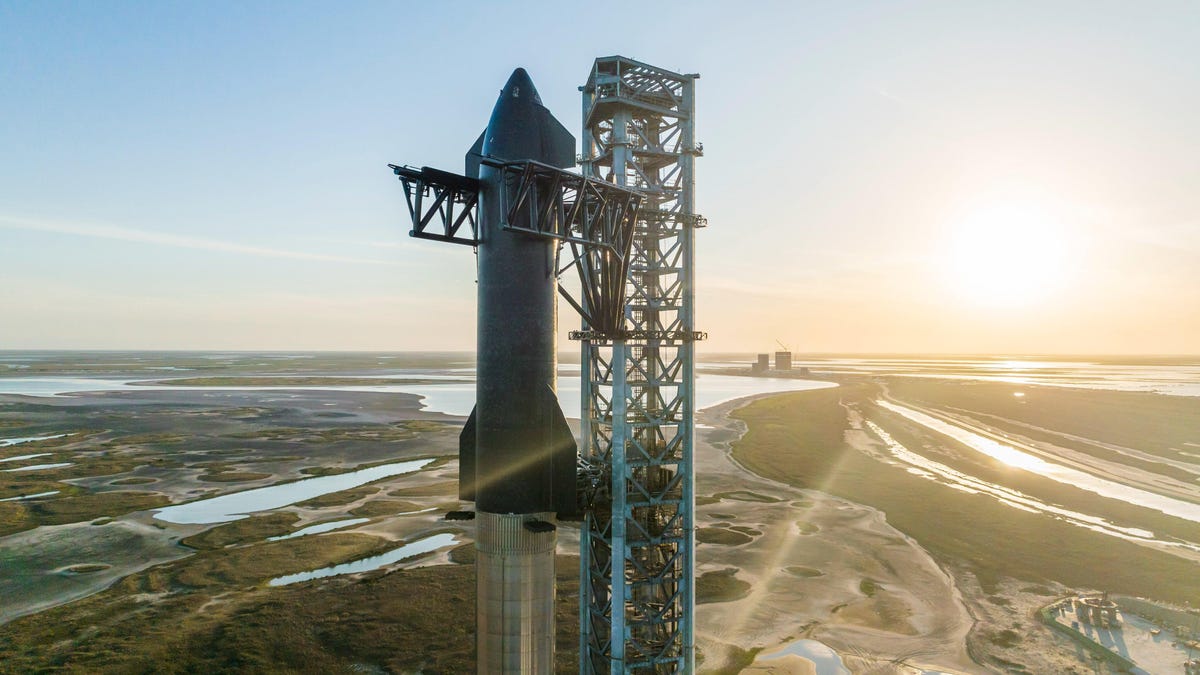SpaceX's Starship Could Launch Just Weeks After NASA's First Artemis Mission
A pair of monster rockets are set to make history before the new year.

SpaceX's Starship rocket stands ready to fly.
There could be a tremendous amount of space travel history made in the closing weeks of 2022 as two long-awaited and game-changing rockets are now set to make their first trips to space within weeks of each other.
NASA says it is confident its new Space Launch System and Orion capsule are ready for blastoff on Nov. 14 for the uncrewed Artemis I mission around the moon, if the weather around Florida cooperates. Meanwhile, another vehicle that the space agency has adopted into its Artemis program to return humans to the moon -- the Starship from SpaceX and Elon Musk -- could finally fly beyond the bounds of Earth's atmosphere for the first time in early December.
Both mega rockets have been years in the making and are ready to set new marks when it comes to power and lifting capacity. If Artemis I does get off the ground next week after several delays, it will become the most powerful operational rocket in the world, and NASA's most powerful ever. But it could be eclipsed just a few weeks later by Starship and its Super Heavy booster, which is designed to deliver even more thrust than the SLS.
All of this is in the service of pushing humans farther out into the solar system, first by establishing a permanent base on the surface of the moon through a series of Artemis missions, and then on to Mars in the 2030s. Both the SLS/Orion combo and Starship will likely play a role in delivering infrastructure and astronauts to the moon over the next decade. NASA selected Starship as a human landing system for the Artemis program last year.
That's the plan, anyway. First, both of these vehicles have to prove they can get off the ground. We've seen the Starship fly high in the atmosphere and come back for a landing, but it has yet to visit space, and the Super Heavy booster needed to make it to the moon hasn't left the surface.
As for Artemis I and SLS, the saga is much longer, with the banger rocket way overbudget and years behind schedule. Attempts to launch in recent months have been set back by engine troubles, pesky leaks and a rude visit from Hurricane Ian. The rocket was rolled back to the huge Vehicle Assembly Building on Cape Canaveral for safe-keeping and repairs. Now it's back on the launch pad, and NASA says it is ready to go for launch just after midnight ET on Nov. 14 (9:07 p.m. PT on Nov. 13).
Meanwhile, Starship is working through a long to-do list leading up to its first orbital flight.
"Right now, the schedule would lead to an early December test flight," NASA's Mark Kirasich, who oversees Artemis development, told an advisory council on Oct. 31.
Between now and then, Starship still needs to conduct a test firing of its engines and perform a "wet dress rehearsal" where fuel is loaded into the rocket and a mock countdown is run. SpaceX also still must secure its launch license from the Federal Aviation Administration, which gave a conditional green light to Starship moving forward in June, but with a laundry list of 75 modifications to the plan that needed to be done first.
Starship's planned first flight will be considerably shorter than that of Artemis I. The SpaceX system will blast off from Texas and make a quick trip to orbit before splashing down in the Pacific off the coast of Hawaii. Artemis, on the other hand, is set to fly Orion around the far side of the moon before coming back to Earth.
NASA plans to begin its livestreaming coverage of the countdown to Artemis I launch on Nov. 11 with a prelaunch briefing at 4 p.m. PT.

